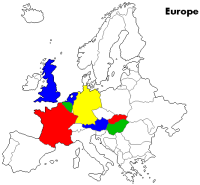An Early Adopter . . .
After a nice slow morning/early afternoon of coffee and conversation, Jan and I left the rig for the Denny’s and WalMart over on I-45.
More and more maskless people at both.
I’m not normally an ‘early adopter’. You know, that person that’s at the front of line after waiting all night to grab up the latest iPhone, see the latest Star Wars movie, or buy tickets for the Beatles Reunion concert (well, since John Lennon and George Harrison are dead, I’d get in line for those tickets too.)
The last time I was actually an early adopter was April 17, 2017, when I bought a Samsung Galaxy S8+ the day it come out. And that’s turned out really good, since I’m still using it. Though I’m looking at upgrading to a S21G Ultra in the near future.
So after almost 4 years, it’s time to do it again.
Just as soon as I confirm that I have a good site picture to the right portion of the sky, I’m signing up for Elon Musk’s new Starlink Internet service. According to their signup page, it should be available in my area between mid and late 2021.
There’s a $99 refundable signup fee, with the hardware costing $499 when it’s ready to ship. Then the service is $99/month.
The 34” Starlink Dish
The Starlink Modem
The reason I’m looking to do this, even though we have free WiFi here at the park, is that we have so many outages, interruptions, and slowdowns, that it’s not that reliable.
In other words, Xfinity sucks.
Right now, we’re lucky to get 10Mbps from the park WiFi, with sometimes only about 3Mbps. And at that speed, we can’t get consistently HD quality video on our streaming.
But beta Starlink users are seeing 50 to 150Mbps, with 300Mbps promised by the end of the year. And Musk says that ultimately they hope get it up to 1Gbps.
Hopefully we’ll be on the schedule pretty soon.
Tomorrow we’re headed up to Webster to have lunch once again at Snooze, but first we’re going to stop by the office so I can start a clone job on the shipping computer. We’re switching both office computers over to the much faster SSD (Solid State Drives). So using WD’s software I’ll clone the old HD onto the new SSD drive, and then just swap them out.
Easy Pezy. I hope.
It normally takes a couple of hours to clone a 1TB drive so I thought I’d get it going before lunch to get a head start. Then while it’s finishing up, I’m going to work on a couple of other things, like getting our new much faster WiFi 6 network in the office working.
Jan’s bringing her Kindles and tablets to keep herself occupied.
As I mentioned yesterday, despite all the warnings of doom and destruction after Gov. Abbott dropped all lockdown/mask mandates for Texas two weeks ago, there has been no spike in cases. In fact, cases are almost exactly half of what they were when Abbott dropped the rules.
Maybe this explains it.
Research Suggests Lockdowns Didn’t Reduce COVID Deaths
A review of data from 87 regions worldwide found that in about 98 percent of the comparisons, there was no evidence that lockdowns reduced the number of COVID-19 deaths.
“Our findings are in accordance with the dataset of daily confirmed COVID-19 deaths/million in the UK. Pubs, restaurants, and barbershops were open in Ireland on June 29th and masks were not mandatory; after more than 2 months, no spike was observed; indeed, death rates kept falling.
“Peru has been considered to be the most strict lockdown country in the world, nevertheless, by September 20th, it had the highest number of deaths/million.”
Put another way, in about 98 percent of the comparisons, there was “no evidence that the number of deaths/million is reduced by staying at home.” The findings were backed up by real-world examples taking place at the time.
Or maybe the lockdowns weren’t really needed after all.
Sweden Saw Lower Mortality Rate Than Most of Europe in 2020, Despite No Lockdown
Preliminary data from EU statistics agency Eurostat compiled by Reuters showed Sweden had 7.7% more deaths in 2020 than its average for the preceding four years. Countries that opted for several periods of strict lockdowns, such as Spain and Belgium, had so-called excess mortality of 18.1% and 16.2% respectively.
Twenty-one of the 30 countries with available statistics had higher excess mortality than Sweden. However, Sweden did much worse than its Nordic neighbours, with Denmark registering just 1.5% excess mortality and Finland 1.0%. Norway had no excess mortality at all in 2020.
But this English judge thinks that many governments will be reluctant to give up their ‘social controls’.
English Supreme Court Judge Expects People Will Be Forced To Wear Masks, Stay Home For TEN YEARS
Sumption’s warning comes in the wake of Public Health England officials stating that restrictions will remain in place for as long as other countries have not vaccinated everyone, a process likely to take years.
Despite promising an end to restrictions in June, the UK government yesterday extended emergency COVID laws until October, with Health minister Matt Hancock refusing to say how long they will remain in place after that.
And it’s not just in England.
Bloomberg Op-Ed: “We Must Start Planning for a Permanent Pandemic”
Bloomberg has published an article by Andreas Kluth which argues that new variants of COVID-19 mean the pandemic will be “permanent” and that there will be an “endless cycle” of restrictions.
Kluth says that the idea the world will at some point go “back to normal” is “almost certainly wrong” and that SARS-CoV-2 will become “our permanent enemy, like the flu but worse.”
Wrapping up, I across this Patient Treatment Guide called A Guide To Home-Based CoVid Treatment.
Put together in consultation with a bunch of doctors and epidemiologists, it’s a concise 26 page guide of how best to treat milder cases of CoVid that don’t require hospitalization, and to help keep it from progressing to the point that hospitalization is required.
Thought For The Day:
SECRET: Something you tell everybody to tell nobody.










